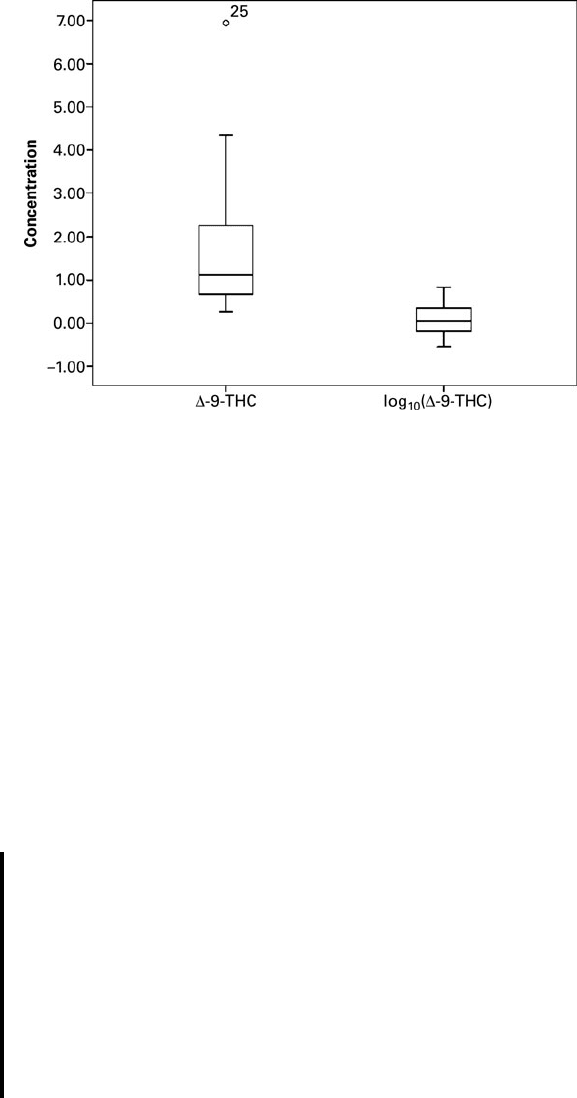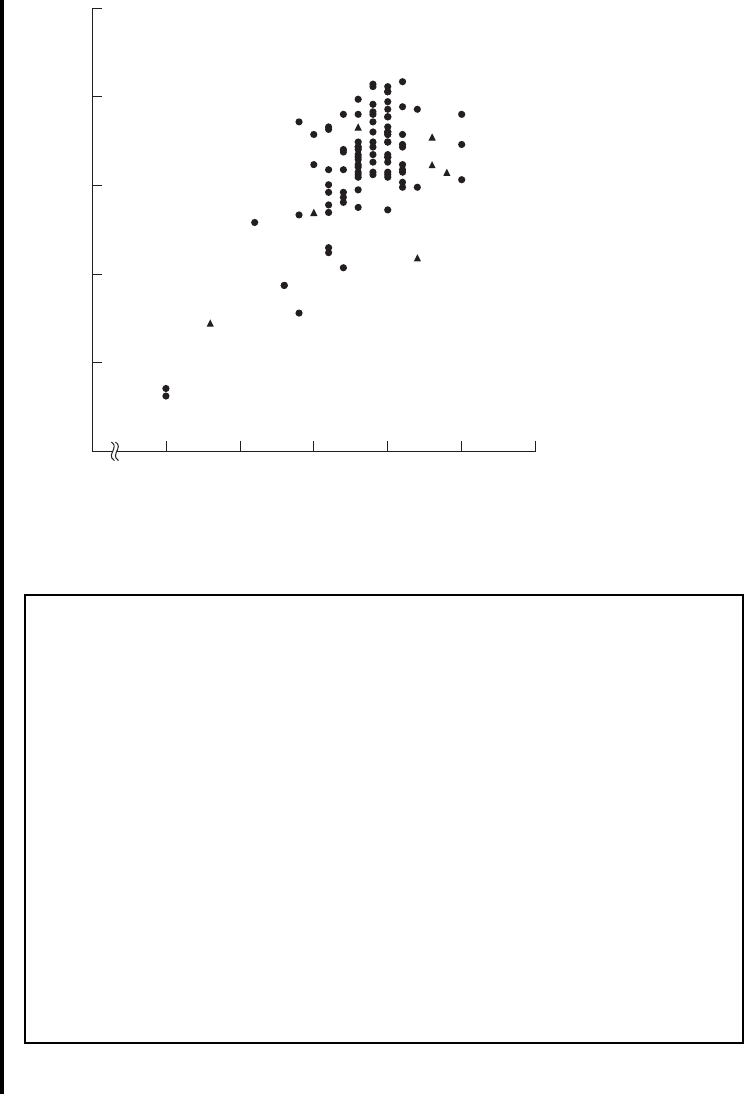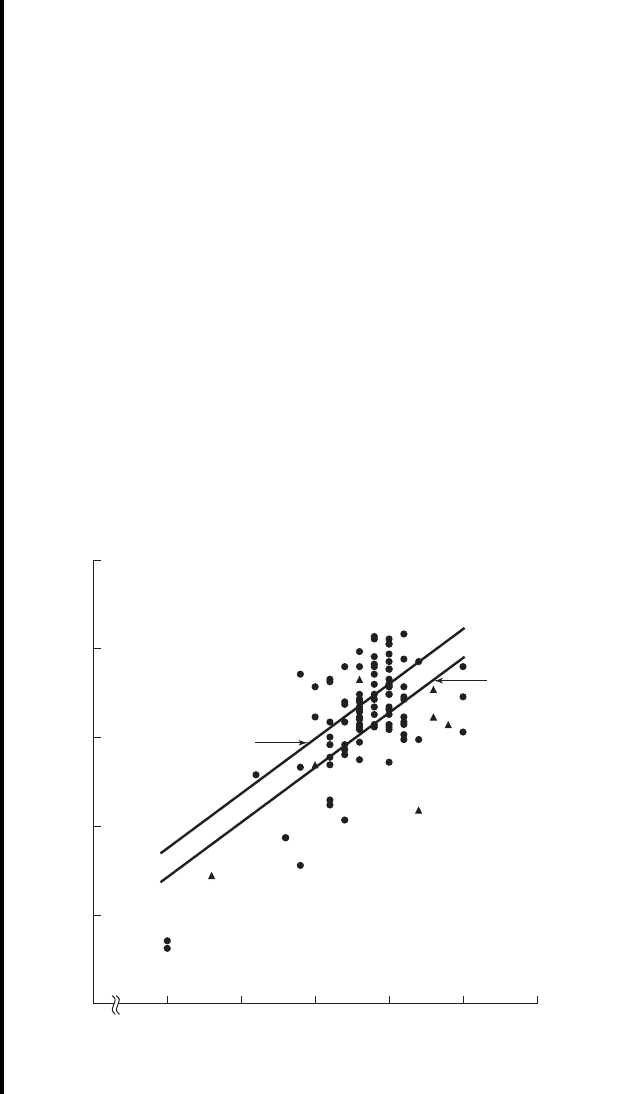Daniel W.W. Biostatistics: A Foundation for Analysis in the Health Sciences
Подождите немного. Документ загружается.


Box-and-whisker plots from SPSS software for these data are shown in Figure 11.1.1.
The raw data are clearly skewed, and an outlier is identified (observation 25). A log
10
transformation, which is often useful for such skewed data, removes the magnitude of
the outlier and results in a distribution that is much more nearly symmetric about the
median. Therefore, the transformed data could be used in lieu of the raw data for con-
structing the regression model. Though symmetric data do not, necessarily, imply that
the data are normal, they do result in a more appropriate model. Formal tests of normal-
ity, as previously mentioned, should always be carried out prior to analysis. ■
Unequal Error Variances
When the variances of the error terms are not equal,
we may obtain a satisfactory equation for the model, but, because the assumption that
the error variances are equal is violated, we will not be able to perform appropriate
hypothesis tests on the model coefficients. Just as was the case in overcoming the
non-normality problem, transformations of the regression variables may reduce the
impact of unequal error variances.
11.1 INTRODUCTION 537
TABLE 11.1.1 Data from a Random Sample of 25 Research
Subjects Tested for -9-THC, Example 11.1.1
Case No. Concentration ( g/ml) Log
10
Concentration ( g/ml)
1 .30 .52
2 2.75 .44
3 2.27 .36
4 2.37 .37
5 1.12 .05
6 .60 .22
7 .61 .21
8 .89 .05
9 .33 .48
10 .85 .07
11 2.18 .34
12 3.59 .56
13 .28 .55
14 1.90 .28
15 1.71 .23
16 .85 .07
17 1.53 .18
18 2.25 .35
19 .88 .05
20 .49 .31
21 4.35 .64
22 .67 .17
23 2.74 .44
24 .79 .10
25 6.94 .84
MM
≤

Correlated Independent Variables
Multicollinearity is a common problem
that arises when one attempts to build a model using many independent variables.
Multicollinearity occurs when there is a high degree of correlation among the
independent variables. For example, imagine that we want to find an equation relating
height and weight to blood pressure. A common variable that is derived from height
and weight is called the body mass index (BMI). If we attempt to find an equation
relating height, weight, and BMI to blood pressure, we can expect to run into analytical
problems because BMI, by definition, is highly correlated with both height and weight.
The problem arises mathematically when the solutions for the regression coefficients
are derived. Since the data are correlated, solutions may not be found that are unique to a
given model. The least complex solution to multicollinearity is to calculate correlations
among all of the independent variables and to retain only those variables that are not highly
correlated. A conservative rule of thumb to remove redundancy in the data set is to elim-
inate variables that are related to others with a significant correlation coefficient above 0.7.
EXAMPLE 11.1.2
A study of obesity and metabolic syndrome used data collected from 15 students, and
included systolic blood pressure (SBP), weight, and BMI. These data are presented in
Table 11.1.2.
Correlations for the three variables are shown in Figure 11.1.2. The very large and
significant correlation between the variables weight and BMI suggests that including both
of these variables in the model is inappropriate because of the high level of redundancy
in the information provided by these variables. This makes logical sense since BMI is a
function of weight. The researcher is now faced with the task of deciding which of the
variables to retain for constructing the regression model.
538 CHAPTER 11 REGRESSION ANALYSIS: SOME ADDITIONAL TECHNIQUES
FIGURE 11.1.1 Box-and-whisker plots of data from Example 11.1.1.

11.2 QUALITATIVE INDEPENDENT VARIABLES
The independent variables considered in the discussion in Chapter 10 were all quantita-
tive; that is, they yielded numerical values that were either counts or measurements in
the usual sense of the word. For example, some of the independent variables used in our
examples and exercises were age, education level, collagen porosity, and collagen ten-
sile strength. Frequently, however, it is desirable to use one or more qualitative variables
as independent variables in the regression model. Qualitative variables, it will be recalled,
are those variables whose “values” are categories and that convey the concept of attrib-
ute rather than amount or quantity. The variable marital status, for example, is a quali-
tative variable whose categories are “single,” “married,” “widowed,” and “divorced.”
Other examples of qualitative variables include sex (male or female), diagnosis, race,
occupation, and immunity status to some disease. In certain situations an investigator
11.2 QUALITATIVE INDEPENDENT VARIABLES 539
TABLE 11.1.2 Data from a Random Sample of 15 Students
Case No. SBP Weight (lbs.) BMI
1 126 125 24.41
2 129 130 23.77
3 126 132 20.07
4 123 200 27.12
5 124 321 39.07
6 125 100 20.90
7 127 138 22.96
8 125 138 24.44
9 123 149 23.33
10 119 180 25.82
11 127 184 26.40
12 126 251 31.37
13 122 197 26.72
14 126 107 20.22
15 125 125 23.62
FIGURE 11.1.2 Correlations calculated in MINITAB software for the data in
Example 11.1.2. ■
Correlations: SBP, Weight, BMI
SBP Weight
Weight 0.289
p-value 0.296
BMI 0.213 0.962
p-value 0.447 0.000

may suspect that including one or more variables such as these in the regression equa-
tion would contribute significantly to the reduction of the error sum of squares and
thereby provide more precise estimates of the parameters of interest.
Suppose, for example, that we are studying the relationship between the dependent
variable systolic blood pressure and the independent variables weight and age. We might
also want to include the qualitative variable sex as one of the independent variables. Or
suppose we wish to gain insight into the nature of the relationship between lung capac-
ity and other relevant variables. Candidates for inclusion in the model might consist
of such quantitative variables as height, weight, and age, as well as qualitative vari-
ables such as sex, area of residence (urban, suburban, rural), and smoking status (cur-
rent smoker, ex-smoker, never smoked).
Dummy Variables In order to incorporate a qualitative independent variable in
the multiple regression model, it must be quantified in some manner. This may be
accomplished through the use of what are known as dummy variables.
DEFINITION
A dummy variable is a variable that assumes only a finite number of
values (such as 0 or 1) for the purpose of identifying the different cate-
gories of a qualitative variable.
The term “dummy” is used to indicate the fact that the numerical values (such as
0 and 1) assumed by the variable have no quantitative meaning but are used merely to
identify different categories of the qualitative variable under consideration. Qualitative
variables are sometimes called indicator variables, and when there are only two cate-
gories, they are sometimes called dichotomous variables.
The following are some examples of qualitative variables and the dummy variables
used to quantify them:
Qualitative Variable Dummy Variable
Sex (male, female):
Place of residence (urban, rural, suburban):
Smoking status [current smoker, ex-smoker
(has not smoked for 5 years or less), ex-smoker
(has not smoked for more than 5 years), never
smoked]:
540
CHAPTER 11 REGRESSION ANALYSIS: SOME ADDITIONAL TECHNIQUES
x
3
= e
1 for ex-smoker 17 5 years2
0 otherwise
x
2
= e
1 for ex-smoker 1… 5 years2
0 otherwise
x
1
= e
1 for current smoker
0 for otherwise
x
2
= e
1 for rural
0 for urban and suburban
x
1
= e
1 for urban
0 for rural and suburban
x
1
= e
1 for male
0 for female

Note in these examples that when the qualitative variable has k categories,
dummy variables must be defined for all the categories to be properly coded. This rule is
applicable for any multiple regression containing an intercept constant. The variable sex, with
two categories, can be quantified by the use of only one dummy variable, while three dummy
variables are required to quantify the variable smoking status, which has four categories.
The following examples illustrate some of the uses of qualitative variables in mul-
tiple regression. In the first example we assume that there is no interaction between the
independent variables. Since the assumption of no interaction is not realistic in many
instances, we illustrate, in the second example, the analysis that is appropriate when inter-
action between variables is accounted for.
EXAMPLE 11.2.1
In a study of factors thought to be associated with birth weight, a simple random sample
of 100 birth records was selected from the North Carolina 2001 Birth Registry (A-1).
Table 11.2.1 shows, for three variables, the data extracted from each record. There are
two independent variables: length of gestation (weeks), which is quantitative, and smok-
ing status of mother (smoke), a qualitative variable. The dependent variable is birth
weight (grams).
k - 1
11.2 QUALITATIVE INDEPENDENT VARIABLES 541
TABLE 11.2.1 Data from a Simple Random Sample of 100 Births from the North
Carolina Birth Registry, Example 11.2.1
Case No. Grams Weeks Smoke
13147400
2 2977 41 0
33119380
4 3487 38 0
54111390
6 3572 41 0
7 3487 40 0
83147410
9 3345 38 1
10 2665 34 0
11 1559 34 0
12 3799 38 0
13 2750 38 0
14 3487 40 0
15 3317 38 0
16 3544 43 1
17 3459 45 0
18 2807 37 0
19 3856 40 0
20 3260 40 0
21 2183 42 1
22 3204 38 0
Case No. Grams Weeks Smoke
51 3232 38 0
52 3317 40 0
53 2863 37 0
54 3175 37 0
55 3317 40 0
56 3714 34 0
57 2240 36 0
58 3345 39 0
59 3119 39 0
60 2920 37 0
61 3430 41 0
62 3232 35 0
63 3430 38 0
64 4139 39 0
65 3714 39 0
66 1446 28 1
67 3147 39 1
68 2580 31 0
69 3374 37 0
70 3941 40 0
71 2070 37 0
72 3345 40 0
(
Continued
)

542 CHAPTER 11 REGRESSION ANALYSIS: SOME ADDITIONAL TECHNIQUES
Case No. Grams Weeks Smoke
23 3005 36 0
24 3090 40 1
25 3430 39 0
26 3119 40 0
27 3912 39 0
28 3572 40 0
29 3884 41 0
30 3090 38 0
31 2977 42 0
32 3799 37 0
33 4054 40 0
34 3430 38 1
35 3459 41 0
36 3827 39 0
37 3147 44 1
38 3289 38 0
39 3629 36 0
40 3657 36 0
41 3175 41 1
42 3232 43 1
43 3175 36 0
44 3657 40 1
45 3600 39 0
46 3572 40 0
47 709 25 0
48 624 25 0
49 2778 36 0
50 3572 35 0
Case No. Grams Weeks Smoke
73 3600 40 0
74 3232 41 0
75 3657 38 1
76 3487 39 0
77 2948 38 0
78 2722 40 0
79 3771 40 0
80 3799 45 0
81 1871 33 0
82 3260 39 0
83 3969 38 0
84 3771 40 0
85 3600 40 0
86 2693 35 1
87 3062 45 0
88 2693 36 0
89 3033 41 0
90 3856 42 0
91 4111 40 0
92 3799 39 0
93 3147 38 0
94 2920 36 0
95 4054 40 0
96 2296 36 0
97 3402 38 0
98 1871 33 1
99 4167 41 0
100 3402 37 1
Source: John P. Holcomb, sampled and coded from North Carolina Birth Registry data found at
www.irss.unc.edu/ncvital/bfd1down.html.
Solution: For the analysis, we quantify smoking status by means of a dummy vari-
able that is coded 1 if the mother is a smoker and 0 if she is a nonsmoker.
The data in Table 11.2.1 are plotted as a scatter diagram in Figure 11.2.1.
The scatter diagram suggests that, in general, longer periods of gestation
are associated with larger birth weights.
To obtain additional insight into the nature of these data, we may enter
them into a computer and employ an appropriate program to perform fur-
ther analyses. For example, we enter the observations
for the first case; for the second
case; and so on. Figure 11.2.2 shows the computer output obtained with the
use of the MINITAB multiple regression program.
x
22
= 0y
2
= 2977, x
12
= 41,40, x
21
= 0,
y
1
= 3147, x
11
=

11.2 QUALITATIVE INDEPENDENT VARIABLES 543
25 30 35 40 45 50
0
1000
2000
3000
4000
5000
Length of gestation (weeks)
Birth weight (grams)
FIGURE 11.2.1 Birth weights and lengths of gestation for 100 births:
( ) smoking and ( ) nonsmoking mothers.
䊉䉱
The regression equation is
grams 1724 130 x1 294 x2
Predictor Coef SE Coef T P
Constant 1724.4 558.8 3.09 0.003
weeks (x1) 130.05 14.52 8.96 0.000
smoke (x2) 294.4 135.8 2.17 0.033
S 484.6 R-Sq 46.4% R-Sq(adj) 45.3%
Analysis of Variance
SOURCE DF SS MS F P
Regression 2 19689185 9844593 41.92 0.000
Residual Error 97 22781681 234863
Total 99 42470867
SOURCE DF Seq SS
x1 1 18585166
x2 1 1104020
FIGURE 11.2.2 Partial computer printout, MINITAB multiple regression analysis.
Example 11.2.1.

544 CHAPTER 11 REGRESSION ANALYSIS: SOME ADDITIONAL TECHNIQUES
25 30 35 40 45 50
0
1000
2000
3000
4000
5000
Length of gestation (weeks)
Nonsmoking
mothers
Birth weight (grams)
Smoking
mothers
FIGURE 11.2.3 Birth weights and lengths of gestation for 100 births and the
fitted regression lines: ( ) smoking and ( ) nonsmoking mothers.
䊉䉱
We see in the printout that the multiple regression equation is
(11.2.1)
To observe the effect on this equation when we wish to consider only
the births to smoking mothers, we let The equation then becomes
(11.2.2)
which has a y -intercept of and a slope of 130. Note that the
y-intercept for the new equation is equal to
Now let us consider only births to nonsmoking mothers. When we let
our regression equation reduces to
(11.2.3)
The slope of this equation is the same as the slope of the equation for
smoking mothers, but the y-intercepts are different. The y-intercept for the
equation associated with nonsmoking mothers is larger than the one for the
=-1724 + 130x
1j
y
N
j
=-1724 + 130x
1j
- 294102
x
2
= 0,
1-29424=-2018.
1b
N
0
+ b
N
1
2= 3-1724 +
-2018
=-2018 + 130x
1j
y
N
j
=-1724 + 130x
1j
- 294112
x
2j
= 1.
y
N
j
=-1724 + 130x
1j
- 294b
N
2
x
2j
y
N
j
= b
N
0
+ b
N
1
x
1j
+ b
N
2
x
2j

smoking mothers. These results show that for this sample, babies born to
mothers who do not smoke weighed, on the average, more than babies born
to mothers who do smoke, when length of gestation is taken into account.
The amount of the difference, on the average, is 294 grams. Stated another
way, we can say that for this sample, babies born to mothers who smoke
weighed, on the average, 294 grams less than the babies born to mothers
who do not smoke, when length of gestation is taken into account. Figure
11.2.3 shows the scatter diagram of the original data along with a plot of
the two regression lines (Equations 11.2.2 and 11.2.3). ■
EXAMPLE 11.2.2
At this point a question arises regarding what inferences we can make about the sam-
pled population on the basis of the sample results obtained in Example 11.2.1. First of
all, we wish to know if the sample difference of 294 grams is significant. In other words,
does smoking have an effect on birth weight? We may answer this question through the
following hypothesis testing procedure.
Solution:
1. Data. The data are as given in Example 11.2.1.
2. Assumptions. We presume that the assumptions underlying multiple
regression analysis are met.
3. Hypotheses. Suppose we let
4. Test statistic. The test statistic is
5. Distribution of test statistic. When the assumptions are met and
is true the test statistic is distributed as Student’s t with 97 degrees of
freedom.
6. Decision rule. We reject if the computed t is either greater than
or equal to 1.9848 or less than or equal to (obtained by inter-
polation).
7. Calculation of test statistic. The calculated value of the test statistic
appears in Figure 11.2.2 as the t ratio for the coefficient associated with
the variable appearing in Column 3 of Table 11.2.1. This coefficient, of
course, is We see that the computed t is
8. Statistical decision. Since we reject
9. Conclusion. We conclude that, in the sampled population, whether the
mothers smoke is associated with a reduction in the birth weights of their
babies.
10. p value. For this test we have from Figure 11.2.2.
■
A Confidence Interval for Given that we are able to conclude that in
the sampled population the smoking status of the mothers does have an effect on the
birth weights of their babies, we may now inquire as to the magnitude of the effect. Our
B
2
p = .033
H
0
.-2.17 6-1.9848,
-2.17.b
N
2
.
-1.9848
H
0
H
0
t = 1b
N
2
- 02>s
b
N
2
.
a = .05.H
0
: b
2
= 0; H
A
: b
2
Z 0.
11.2 QUALITATIVE INDEPENDENT VARIABLES 545
best point estimate of the average difference in birth weights, when length of gestation
is taken into account, is 294 grams in favor of babies born to mothers who do not smoke.
We may obtain an interval estimate of the mean amount of the difference by using infor-
mation from the computer printout by means of the following expression:
For a 95 percent confidence interval, we have
Thus, we are 95 percent confident that the difference is somewhere between about 564
grams and 25 grams.
Advantages of Dummy Variables The reader may have correctly surmised
that an alternative analysis of the data of Example 11.2.1 would consist of fitting two
separate regression equations: one to the subsample of mothers who smoke and another
to the subsample of those who do not. Such an approach, however, lacks some of the
advantages of the dummy variable technique and is a less desirable procedure when the
latter procedure is valid. If we can justify the assumption that the two separate regres-
sion lines have the same slope, we can get a better estimate of this common slope through
the use of dummy variables, which entails pooling the data from the two subsamples. In
Example 11.2.1 the estimate using a dummy variable is based on a total sample size of
100 observations, whereas separate estimates would be based on a sample of 85 smok-
ers and only 15 nonsmokers. The dummy variables approach also yields more precise
inferences regarding other parameters since more degrees of freedom are available for
the calculation of the error mean square.
Use of Dummy Variables: Interaction Present Now let us consider
the situation in which interaction between the variables is assumed to be present. Sup-
pose, for example, that we have two independent variables: one quantitative variable
and one qualitative variable with three response levels yielding the two dummy variables
and The model, then, would be
(11.2.4)
in which and are called interaction terms and represent the interaction
between the quantitative and the qualitative independent variables. Note that there is no
need to include in the model the term containing it will always be zero because
when , and when The model of Equation 11.2.4 allows
for a different slope and Y-intercept for each level of the qualitative variable.
Suppose we use dummy variable coding to quantify the qualitative variable as follows:
X
3
= e
1 for level 2
0 otherwise
X
2
= e
1 for level 1
0 otherwise
X
3
= 1, X
2
= 0.X
2
= 1, X
3
= 0
X
2j
X
3j
;
b
5
X
1j
X
3j
b
4
X
1j
X
2j
y
j
= b
0
+ b
1
X
1j
+ b
2
X
2j
+ b
3
X
3j
+ b
4
X
1j
X
2j
+ b
5
X
1j
X
3j
+P
j
X
3
.X
2
X
1
-563.9, -24.9
-294.4 ; 1.98481135.82
b
N
2
; ts
b
N
2
546 CHAPTER 11 REGRESSION ANALYSIS: SOME ADDITIONAL TECHNIQUES
